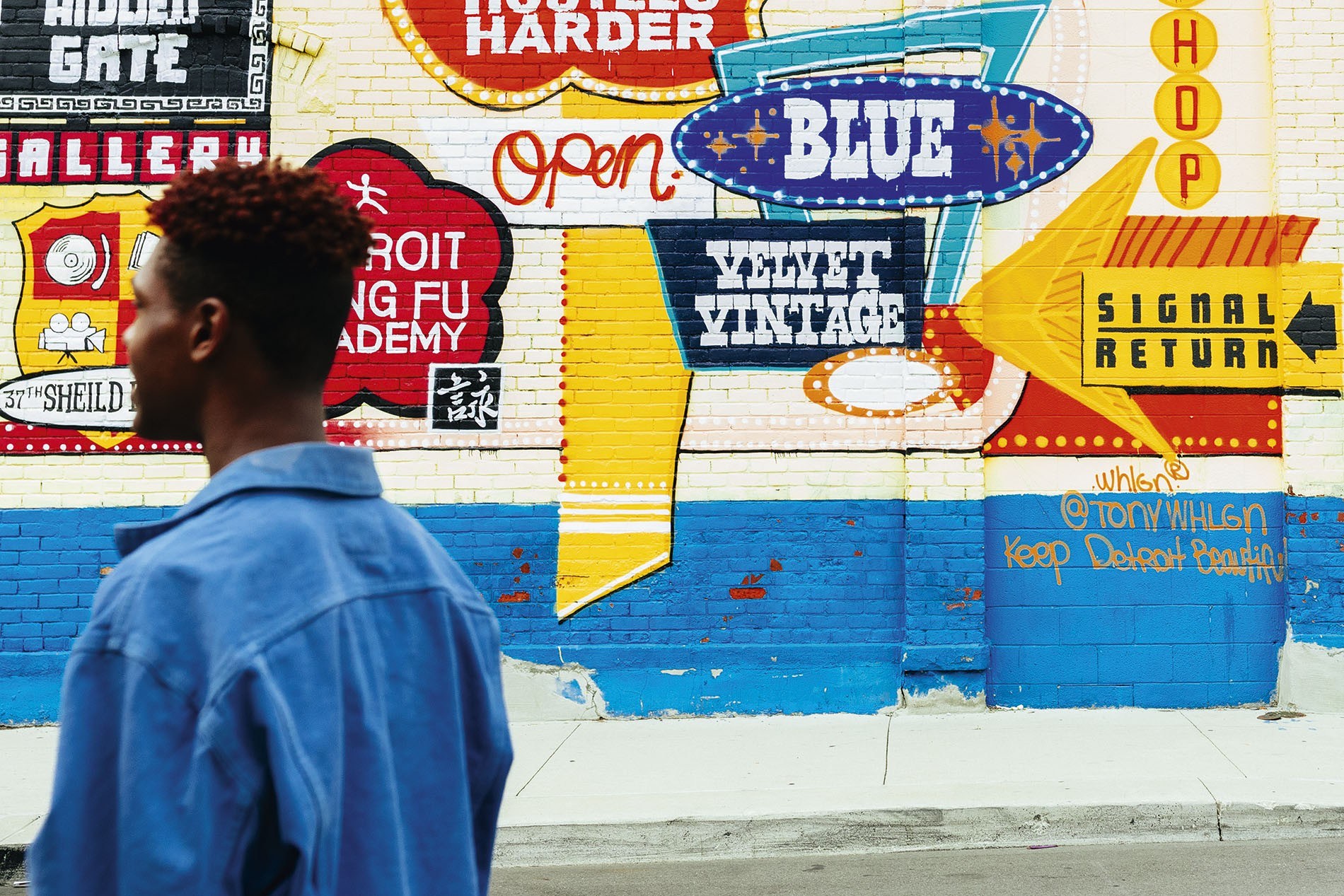
A wave of civic pride has seen this one-time Michigan powerhouse bounce back from bankruptcy to become a vibrant hotbed of creativity
Read online at nationalgeographic.com
“Hey, come in!” engineer Bill Skibbe says, removing his headphones and waving me into his mixing studio. He deftly lifts a 12-inch single off a turntable, spins it between his fingers and places it gently under a microscope. “Let’s have a look at what I just cut.” Under the lens, the minute stylus grooves are as large and smooth as rivers. “Where it squiggles, that’s where there’s bass,” Bill explains. He seems satisfied with the result and leans back in his chair.
“Vinyl’s a three-dimensional sonic experience,” Bill says. “It’s more sympathetic to the human ear. And it’s a much greener way to listen to music — there are no servers with giant carbon footprints. We had Mark Zuckerberg walk in here the other day. I think it blew his mind that we’re using this old technology; it’s practically unchanged since Thomas Edison. But me, I’m in love with the physicality of vinyl. So this place,” he says, throwing open his arms, “is my mecca.”
I’m poking around Third Man Records, the Midtown music emporium that Detroit native, rock star Jack White (of The White Stripes fame) opened in 2015. There’s a stylish shop and performance space out front, stuffed with T-shirts and token-operated jukeboxes. And at the back, down a low-lit corridor, past Bill’s studio, is a whirring record-pressing plant. The floor is varnished a funky, chemical-spill yellow, and the workers sport branded boiler suits and cool haircuts, looking like they’re fresh off a shoot for Rolling Stone.
Bill tells me there are only a few other places in the world where you can record a live album, then have it mixed and cut to vinyl in the same space. “It’s unconventional, but that’s Detroit,” he grins. “The craziest part was when Jack told me he’d opened on the Cass Corridor. I was gigging round here in the ’90s, and it was not a neighbourhood you felt safe in. But it’s completely turned around. I mean, there’s even a dog park!”
Midtown’s resurrection from seedy no-man’s land to a flourishing retail area that’s home to microbreweries and off-beat businesses is part of a tide of uplift and reinvestment that, in just a few years, has revitalised the depopulated heart of Detroit.
For the first half of the 20th century, Detroit was America’s wealthiest and most influential city, but in the 1950s racial tensions and declining industry triggered an exodus. The once-grand city staggered on, beset by crime and corruption, until it collapsed, filing for Chapter 9 bankruptcy in July 2013. Rock bottom, however, had a galvanising effect; the city began to reimagine itself.
“There were no rules, so people made them up,” explains Dan Armand when I arrive in Eastern Market — a district characterised by Victorian storehouses and ramshackle lots that’s popular with young creatives. In 2015, Dan launched the annual Murals in the Market festival, turning his depressed neighbourhood into a canvas for international and local street artists. “There’s a lot of pride in Detroit,” he tells me. “Those who stayed are passionate about this city. And there’s a can-do attitude because we want more for ourselves. Like when people got together and formed ‘lawnmower brigades’ to tidy up abandoned lots.”
As a result of the festival, 125 murals are now splashed across warehouse walls, subterranean spaces and water towers.
As we explore, Dan points out works by Detroit artists. There are the signature stylised flowers of Ouizi, a marching band by Pat Perry, and works by Olayami Dabls and Tyree Guyton.
“A lot of local artists started out doing graffiti right here, before the clean-up,” Dan tells me as we enter Dequindre Cut, a two-mile sunken greenway between Downtown and Eastern Market. The leafy corridor, created along a defunct railroad a decade ago, is a picture of urban progress and harmony; street art brightens underpasses, while joggers and cyclists weave around us on the footpath. “I remember there were just layers and layers of graffiti,” Dan says. “It’s crazy to see it now.”
We part ways in the marketplace from which the area takes its name. It’s Saturday — market day, a cornerstone of city life since 1891 — and 225 vendors have taken over the ‘sheds’, many selling vegetables or honey from urban farms set up in some of the city’s tens of thousands of empty lots. The whole of Detroit seems to be here.
Down the road, I stop at Bert’s Market Place, one of the city’s oldest jazz clubs, where people are tucking into soul food on street-side tables. Ribs sizzle on a barbecue and there’s Motown on the stereo. An excited wedding party piles out of a bus and begins lining up for photos in front of a psychedelic mural. In the distance, Downtown’s huddle of art deco skyscrapers cuts a striking silhouette against the cloudless sky. The city feels alive and safe, and it looks gorgeous. I have to admit, it’s not at all what I expected.
On the world stage
Karin Risko, owner of City Tour Detroit, clearly enjoys opening travellers’ eyes to their misconceptions about the city. “Not how you imagined, is it?” she asks, as we amble along the River Walk. Part of Detroit International Riverfront, the 5.5-mile promenade leads all the way from Downtown to bucolic island park, Belle Isle, past pavilions, flowerbeds and even a sandy beach. “A lot of what people think of when you say ‘Detroit’ are these grand, empty skyscrapers going to ruin, or Michigan Central Station, with its windows boarded up,” Karin says. “It’s been the focus of a ruin porn feeding frenzy for years. That was the only story the media wanted to tell.”
Built in 1913, Michigan Central Station was created by the same architects who designed New York’s Grand Central Terminal. When it closed in 1988, its vaulted ticket halls became a magnet for techno raves and urban scavengers. The building — in Corktown, the city’s oldest immigrant neighbourhood, now a burgeoning bastion of small bars and brunch spots — is finally about to be brought back to life, by Ford Motor Company, no less: a colossus of the automotive industry that underpinned the city at its peak.
The poster child for Detroit’s fall from grace, the station is a beacon for its triumphant regeneration. But Karin is keen to stress the recent uptick in Detroit’s fortunes isn’t — for anyone with at least a passing interest in history — the most interesting thing about the city. “People think Detroit is some new discovery. All the new restaurants and hotels in the centre are great,” she concedes, “but we have a long history of contributing not just to America, but to the world.” To illustrate her point, Karin tells me about Detroiters’ pivotal role in the Underground Railroad — a network of safe houses and people that helped escaped slaves to cross the border to freedom in Canada. She then relates sensational tales of speakeasies and smuggling gangs from the Prohibition era — an estimated 80% of America’s bootleg booze entered the country here — and stories of how the Motor City swung the tide of the Second World War by mass-producing munitions. This is the city that produced sporting legends like the boxer Joe Louis; Motown music and epoch-defining singers like Stevie Wonder and The Supremes.
It was also the birthplace of Fordist industrialism and a place where a migrant labourer could make a middle-class wage. “We had more theatre seats than anywhere outside of Broadway,” Karin tells me proudly as we pass under the multistorey neon marquee of the Fox Theatre cinema.
Touring Downtown with Karin, it’s easy to imagine the grandeur of the city during the Roaring Twenties. Ornate skyscrapers make canyons of the wide boulevards, and steam escapes from vents in the road, the product of an antique cooling system still used by over 100 buildings. Half a century of stagnation has resulted, inadvertently, in the preservation of the architectural charms of another era. Best of all, there’s not a Starbucks or McDonald’s in sight — although, considering the rate of regeneration in the area, this might not be the case for much longer.
As the sun sets, Downtown heats up. The plaza of Campus Martius Park is full of trendy urbanites drinking cocktails, and the bars in The Belt — a nondescript alleyway reimagined as a muraled corridor of eclectic watering holes — are starting to get busy.
A number of far-sighted hoteliers and restaurateurs have helped flesh out a renaissance in these parts, kick-started by Detroit-born investor Dan Gilbert. His company, Bedrock, has bought, renovated and reopened over 100 historical buildings at the city’s heart. Largely down to him, Downtown is flourishing, handsome and safe for travellers to wander about in, day or night. One of Bedrock’s most high-profile successes has been Shinola, a luxury goods brand that set up shop in the then-crumbling capital of Michigan back in 2011 and confounded business experts by turning a profit. This January, the 129-room boutique Shinola Hotel followed. Billing itself as ‘Detroit’s new living room’, most of the staff grew up locally and the interior’s artworks and flourishes are predominantly sourced from Michigan. The global buzz that accompanied the opening seems solid evidence the city is truly set for a comeback. Some locals, however, remain sceptical. After all, over the decades there have been many false dawns.
My last stop of the trip is Bad Luck Bar — an establishment whose name belies the admiration it’s stirred up among mixology geeks in the three years since it opened. No sign hangs outside the alleyway entrance — a serpent, painted in black on the door is the only hint at what lies within. Inside, a heavy curtain is drawn aside by a hostess and I’m ushered into an intimate, low-lit bar. I select ‘Metamorphosis’ from a drinks list styled like a deck of tarot cards. ‘Progression’ and ‘change’, it promises, will be my reward for imbibing the mix of banana-infused blackstrap rum, white rum, milk, masala syrup, lemon juice and bitters.
I think it’s a fitting salute to the city as it enters a new phase. Dan Kwiatkowski, the owner, demurs. “‘Renaissance’ is a bit of a dirty word round here. It’s been thrown around, on and off, for years. But maybe, when you look around at everything that’s happening…” He pauses, as if scared to jinx it. “It is hard to deny.” I’ll be the one to say it out loud: Detroit? You can call it a comeback.
Essentials
Getting there & around
Delta Air Lines, Air France, KLM and Virgin Atlantic all fly direct to Detroit Metro Airport from Heathrow.
Average flight time: 8h40m.
The QLine streetcar connects Downtown and Midtown. A regular fare is $1.50 (£1.24) for three hours or $3 (£2.48) for a day pass. The Detroit People Mover, an elevated light rail line, circles Downtown and a journey costs $0.75 (62p). Uber and Lyft taxis are available via their respective apps, while ride-share bikes can be picked up with MoGo. Lime, Bird and Spin offer electric scooters.
When to go
Summer (June-August) sees highs of 30C; winter (December-February) ranges from -6C to 2C.
Where to stay
Rooms at Shinola Hotel from $255 (£205) a night, room only.
More info
visitdetroit.com
visittheusa.co.uk/music
Grand Circus Magazine
Murals in the Market
A History Lover’s Guide to Detroit, Karin Risko. RRP: $21.99 (£18.13)
How to do it
Audley Travel offers tailor-made trips to the Great Lakes. An eight-day, self-drive costs from £2,290 per person (based on two sharing). Includes three nights at Shinola Hotel plus time in Sleeping Bear Dunes National Lakeshore and Mackinac Island, international flights, transfers, car hire, room-only accommodation and some excursions.
Published in the October 2019 issue of National Geographic Traveller (UK)











